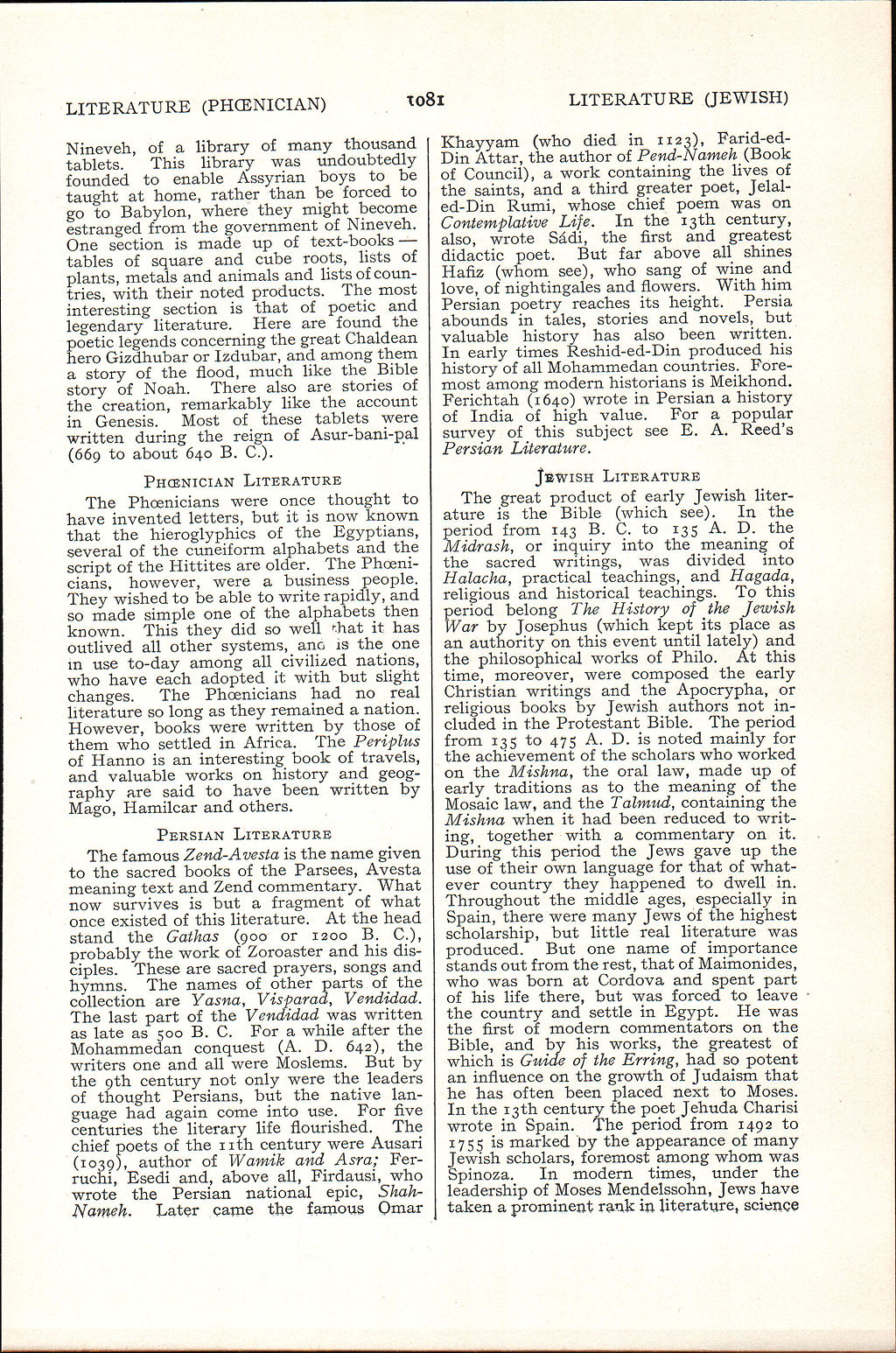Nineveh, of a library of many thousand
tablets. This library was undoubtedly
founded to enable Assyrian boys to be
taught at home, rather than be forced to
go to Babylon, where they might become
estranged from the government of Nineveh.
One section is made up of text-books—tables
of square and cube roots, lists of
plants, metals and animals and lists of
countries, with their noted products. The most
interesting section is that of poetic and
legendary literature. Here are found the
poetic legends concerning the great Chaldean
hero Gizdhubar or Izdubar, and among them
a story of the flood, much like the Bible
story of Noah. There also are stories of
the creation, remarkably like the account
in Genesis. Most of these tablets were
written during the reign of Asur-bani-pal
(669 to about 640 B. C.).
Phœnician Literature
The Phœnicians were once thought to have invented letters, but it is now known that the hieroglyphics of the Egyptians, several of the cuneiform alphabets and the script of the Hittites are older. The Phœnicians, however, were a business people. They wished to be able to write rapidly, and so made simple one of the alphabets then known. This they did so well that it has outlived all other systems, and is the one in use to-day among all civilized nations, who have each adopted it with but slight changes. The Phœnicians had no real literature so long as they remained a nation. However, books were written by those of them who settled in Africa. The Periplus of Hanno is an interesting book of travels, and valuable works on history and geography are said to have been written by Mago, Hamilcar and others.
Persian Literature
The famous Zend-Avesta is the name given to the sacred books of the Parsees, Avesta meaning text and Zend commentary. What now survives is but a fragment of what once existed of this literature. At the head stand the Gathas (900 or 1200 B. C.), probably the work of Zoroaster and his disciples. These are sacred prayers, songs and hymns. The names of other parts of the collection are Yasna, Visparad, Vendidad. The last part of the Vendidad was written as late as 500 B. C. For a while after the Mohammedan conquest (A. D. 642), the writers one and all were Moslems. But by the 9th century not only were the leaders of thought Persians, but the native language had again come into use. For five centuries the literary life flourished. The chief poets of the 11th century were Ausari (1039), author of Wamik and Asra; Ferruchi, Esedi and, above all, Firdausi, who wrote the Persian national epic, Shah-Nameh. Later came the famous Omar Khayyam (who died in 1123), Farid-ed-Din Attar, the author of Pend-Nameh (Book of Council), a work containing the lives of the saints, and a third greater poet, Jelal-ed-Din Rumi, whose chief poem was on Contemplative Life. In the 13th century, also, wrote Sádi, the first and greatest didactic poet. But far above all shines Hafiz (whom see), who sang of wine and love, of nightingales and flowers. With him Persian poetry reaches its height. Persia abounds in tales, stories and novels, but valuable history has also been written. In early times Reshid-ed-Din produced his history of all Mohammedan countries. Foremost among modern historians is Meikhond. Ferichtah (1640) wrote in Persian a history of India of high value. For a popular survey of this subject see E. A. Reed's Persian Literature.
Jewish Literature
The great product of early Jewish literature is the Bible (which see). In the period from 143 B. C. to 135 A. D. the Midrash, or inquiry into the meaning of the sacred writings, was divided into Halacha, practical teachings, and Hagada, religious and historical teachings. To this period belong The History of the Jewish War by Josephus (which kept its place as an authority on this event until lately) and the philosophical works of Philo. At this time, moreover, were composed the early Christian writings and the Apocrypha, or religious books by Jewish authors not included in the Protestant Bible. The period from 135 to 475 A. D. is noted mainly for the achievement of the scholars who worked on the Mishna, the oral law, made up of early traditions as to the meaning of the Mosaic law, and the Talmud, containing the Mishna when it had been reduced to writing, together with a commentary on it. During this period the Jews gave up the use of their own language for that of whatever country they happened to dwell in. Throughout the middle ages, especially in Spain, there were many Jews of the highest scholarship, but little real literature was produced. But one name of importance stands out from the rest, that of Maimonides, who was born at Cordova and spent part of his life there, but was forced to leave the country and settle in Egypt. He was the first of modern commentators on the Bible, and by his works, the greatest of which is Guide of the Erring, had so potent an influence on the growth of Judaism that he has often been placed next to Moses. In the 13th century the poet Jehuda Charisi wrote in Spain. The period from 1492 to 1755 is marked by the appearance of many Jewish scholars, foremost among whom was Spinoza. In modern times, under the leadership of Moses Mendelssohn, Jews have taken a prominent rank in literature, science
